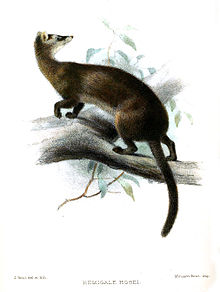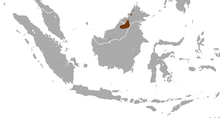Diplogale
| Hose's palm civet | |
|---|---|
 |
|
| Scientific classification | |
| Kingdom: | Animalia |
| Phylum: | Chordata |
| Class: | Mammalia |
| Order: | Carnivora |
| Family: | Viverridae |
| Subfamily: | Hemigalinae |
| Genus: |
Diplogale Thomas, 1912 |
| Species: | D. hosei |
| Binomial name | |
|
Diplogale hosei (Thomas, 1892) |
|
 |
|
| Hose's palm civet range | |
Hose's palm civet (Diplogale hosei), also known as Hose's civet, is a civet species endemic to the island of Borneo. It is listed on the IUCN Red List as Vulnerable because of an ongoing population decline, estimated to be more than 30% over the last three generations (inferred to be 15 years) and suspected to be more than 30% in the next three generations due to declines in population inferred from habitat destruction and degradation.
Diplogale is a monospecific genus. Hose's palm civet was named after the zoologist Charles Hose by Oldfield Thomas in 1892. Hose collected the first specimen in Sarawak in 1891.
What little is known of the species comes primarily from 17 museum specimens worldwide. Only in 1997, the first living specimen was obtained and released after 2 months – there remains no Hose’s civet in captivity anywhere in the world.
The upperparts (from nose to tail tip, including outer surfaces of the four limbs) are dark brown to blackish brown and the underparts (from the chin to the tip of the tail and the inner surface of all four limbs) are white or slightly brownish white. The face has dark rings around the eyes and very long, white facial whiskers (sensory hairs) and the large, wet snout (rhinarium) has a contrasting flesh colour. The two nostrils protrude widely, diverging to open on both sides. The under surfaces of the feet are pale (flesh coloured) and the footpads are brown. The feet are partly webbed, with patches of short hair between the footpads.
The Hose’s civet has a head-body length of 472–540 millimetres (18.6–21.3 in), a tail of 298–346 millimetres (11.7–13.6 in), a hind foot length of 74–81 millimetres (2.9–3.2 in) and an ear length of 36–39 millimetres (1.4–1.5 in); it is estimated to weigh about 1.4–1.5 kilograms (3.1–3.3 lb) and has 40 teeth.
...
Wikipedia

